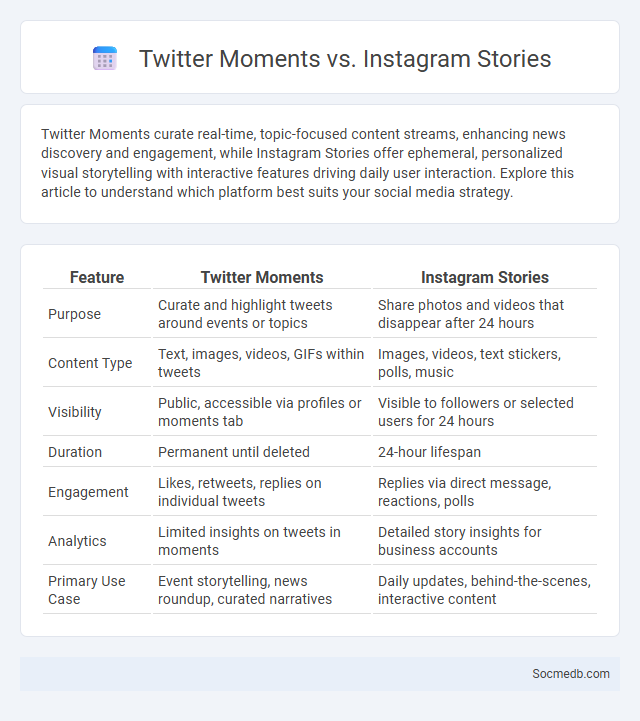
Photo illustration: Twitter Moments vs Instagram Stories
Twitter Moments curate real-time, topic-focused content streams, enhancing news discovery and engagement, while Instagram Stories offer ephemeral, personalized visual storytelling with interactive features driving daily user interaction. Explore this article to understand which platform best suits your social media strategy.
Table of Comparison
| Feature | Twitter Moments | Instagram Stories |
|---|---|---|
| Purpose | Curate and highlight tweets around events or topics | Share photos and videos that disappear after 24 hours |
| Content Type | Text, images, videos, GIFs within tweets | Images, videos, text stickers, polls, music |
| Visibility | Public, accessible via profiles or moments tab | Visible to followers or selected users for 24 hours |
| Duration | Permanent until deleted | 24-hour lifespan |
| Engagement | Likes, retweets, replies on individual tweets | Replies via direct message, reactions, polls |
| Analytics | Limited insights on tweets in moments | Detailed story insights for business accounts |
| Primary Use Case | Event storytelling, news roundup, curated narratives | Daily updates, behind-the-scenes, interactive content |
Overview: Understanding Twitter Moments, Instagram Stories, and Tips
Twitter Moments highlight curated tweets and trending content to help users discover breaking news and popular topics efficiently. Instagram Stories allow users to share temporary photos and videos that disappear after 24 hours, fostering real-time engagement and interactive features like polls and stickers. To optimize social media strategy, focus on creating timely, visually appealing content tailored to each platform's unique format and audience behavior.
Core Features Comparison
Social media platforms differ significantly in core features such as user engagement tools, content types supported, and algorithm-driven content curation. Facebook offers robust community groups and extensive multimedia sharing, while Instagram emphasizes visual storytelling with photo and video posts, stories, and shopping integrations. Twitter prioritizes real-time information dissemination through tweets and trending hashtags, enabling dynamic public conversations.
Content Creation Process
Effective social media content creation involves researching target audience preferences, brainstorming relevant topics, and crafting visually appealing posts that drive engagement. Utilizing tools like content calendars and analytics platforms helps optimize publishing schedules and measure performance. Consistent testing and adaptation based on feedback enhance the overall strategy, ensuring increased reach and brand visibility.
Audience Engagement and Interaction
Maximizing audience engagement and interaction on social media requires understanding your followers' preferences and behaviors through analytics tools. Creating interactive content, such as polls, Q&A sessions, and live videos, encourages direct participation and strengthens community bonds. Your consistent responsiveness to comments and messages boosts trust and fosters a loyal, engaged audience.
Visual and Multimedia Capabilities
Social media platforms leverage advanced visual and multimedia capabilities to enhance user engagement and content sharing. Features such as high-resolution photo uploads, live video streaming, augmented reality filters, and interactive stories drive richer communication experiences. Enhanced algorithms optimize content delivery based on visual preference analytics, amplifying user interaction and platform retention.
Duration and Visibility of Content
Social media content duration varies by platform, with formats like Instagram Stories lasting 24 hours and TikTok videos remaining indefinitely, affecting user engagement and reach. Visibility depends on algorithms prioritizing recent interactions, relevance, and user behavior, influencing how long and widely content is seen. Optimizing post timing and engagement metrics enhances both the duration and visibility of social media content.
Analytics and Performance Tracking
Social media analytics provides in-depth insights into user engagement, content reach, and audience demographics, enabling you to refine your strategy effectively. Performance tracking tools measure key metrics such as click-through rates, impressions, and conversions, helping identify which campaigns deliver the best ROI. Leveraging these data-driven insights ensures your social media efforts align with business goals and maximize overall impact.
Branding and Marketing Opportunities
Social media platforms provide unparalleled branding and marketing opportunities by enabling direct engagement with target audiences, fostering brand loyalty, and increasing visibility through tailored content strategies. Businesses can leverage data analytics and influencer partnerships to optimize campaign performance and drive conversion rates. Consistent brand messaging across channels enhances recognition while social listening tools help adapt strategies based on consumer sentiment and trends.
Use Cases: When to Use Each Feature
Social media platforms offer diverse features tailored for specific use cases, such as Instagram Stories for real-time updates and ephemeral content, LinkedIn articles for professional thought leadership, and Twitter threads for concise news sharing. Utilizing Facebook Groups fosters community engagement and targeted discussions, while TikTok's short-form videos excel in viral marketing and creative brand storytelling. Selecting the appropriate feature depends on goals like audience engagement, content type, and desired interaction style.
Final Verdict: Choosing the Right Platform for Your Needs
Selecting the right social media platform depends on your specific goals, target audience, and content type. Platforms like Instagram and TikTok excel in visual engagement, while LinkedIn is ideal for professional networking and B2B connections. Evaluating your unique needs ensures maximum impact and effective social media strategy execution.
 socmedb.com
socmedb.com